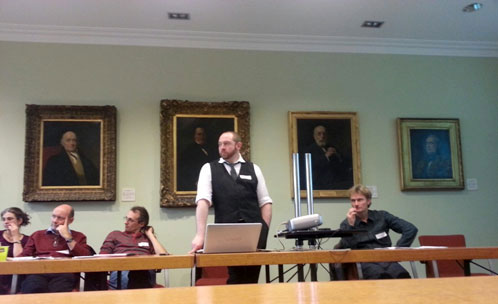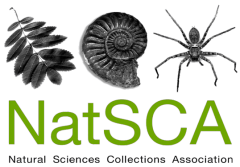An Update from the National Nature Collections Information Project
At the end of last year, the Natural History Museum (NHM), Linnean Society London, and Natural Sciences Collections Association (NatSCA) held a workshop at The Linnean Society to agree a project proposal for a collections-level information system for natural science collections in the UK, under the title National Nature Collections Information Project (abbreviated to #NatureData).

It was a consultation meeting, involving natural science professionals from across the UK, meant to identify some clear and actionable outcomes to address the need for information on not only the location and contents of natural science collections throughout the UK, but their status e.g. are they at risk. There's a strategic need to define and follow a nationally agreed upon direction for how we make the most of our natural science collections in terms of sustainability and accessibility. There are a wealth of existing databases, resources and initiatives but some discordance in terms of their goals, their long term sustainability and their usability across all kinds of collection types.
An understanding of the distribution of general natural science collections is also recognised as a necessary resource to improve collections access for a variety of non-taxonomic users, including artists, academic researchers and biological recorders. Therefore, much of what was discussed at the meeting centred on the questions: ‘how can we create an information system for UK natural science collections? Is one needed, if so who is it for and what could it look like and what would its function be?
The workshop lasted from 11.00am until 4.00pm. It was an intense discussion, at times becoming a heated debate - you can see the concentration of those in the room in the picture below. From this crucible of consultation emerged the realisation that:
- a single system could not be created for the multitude of possible users that were identified; specialists, curators, the general public, scientists, researchers, museum professionals, councillors etc.
- some good data already exists (e.g. FENSCORE, Herbaria@home, etc.) that could possibly provide the basis of a system, if a suitable portal could be created to combine them and make them accessible (with the caveat that some of the information may be out-of-date and poorly standardised).
- user demand needs to be addressed. If a new system was created, would it be used? The experience in the room identified that a system would only be used if was needed and properly marketed/communicated. There’s no point having a system that is unknown and therefore unused.
- it was too early to think about the wider concept as a project and that a clear project structure needed to be developed to make real progress
You can read some of the questions or thoughts raised at the meeting on storify here.
Outcomes
Emerging from that first #NatureData meeting was recognition of the need to narrow down the scope to identify clear uses for, and users of, the data; such as the need to inform a strategic approach to UK taxonomic collections for systematics, to allow locations of collections to be identified by researchers, amateur naturalists and other stakeholders, and to flag collections at risk for NatSCA’s advocacy work.
It was great to see how the attendees engaged with the topic; raising questions that informed the actions needed to take the project forward. Once these actions were identified four working groups formed to research specific themes to help shape a better defined project plan.
The museums/organisations working together in groups include the Collections Trust, NHM, NatSCA, Birmingham Museums Trust, Manchester Museum, Linking Collections in Wales, Geological Curators Group (GCG), and Oxford University Museum of Natural History. The working groups that emerged focussed on:
- Defining users (deciding upon a target audience): Undertaken by NatSCA.
- Identifying the natural science collections in the UK (what is the scope for inclusion in the database?)
- Identify the composition of those collections (what are the minimum data standard requirements to make the data useful?)
- Data (1. specify competencies: scoping questions users will ask? 2. database options that meet these specifications: what model and framework would be suitable?)
NB: The research from each of the working groups in relation to 1, 2, 3, and 4 will be available here on the NatSCA website soon.
A result of the consultation was that initially a Coordinating Committee was set up, made up of David Cutler (Linnean Society), Paolo Viscardi (NatSCA / Horniman Museum & Gardens), Mark Carnall (Grant Museum of Zoology), Nick Poole (Collections Trust) and Rob Huxley (NHM), with the idea to manage the project. This Committee met at the beginning of February to assess and discuss the research and recommendations from the working groups and discuss next steps. At this meeting it was identified that the role of the Committee was one of consultation to ensure synergy, and highlight any duplication. Two clear project strands were decided upon, with different time-scales and different resourcing requirements:
- Natural History Near You – a crowdsourcing project primarily guided by NatSCA, using Google systems to ask the natural science community to populate a database of collections in the UK and Ireland, identifying top-level information such as location, basic type of material held, size of collection and potential risks to collections. This will feed into:
- UK Natural Science Collections Connecting – a project primarily funded by the NHM and working in collaboration with the Collections Trust. Over the next year the NHM UK National Programme: Collections will fund the creation of a UK Collections Information System using a sustainable open source model (infrastructure developed by the Collections Trust and NHM) to share more detailed information about the composition of natural science collections in the UK. Working with a consortium of museums, organisations and herbaria to populate the system. Part of this pilot project will seek to develop appropriate secondment opportunities.
More details of the two project strands of will be shared as they develop via NatSCA. The Co-ordinating Committee will meet every three months to share progress, highlight any links or duplication. In the meantime, if you have any questions or thoughts please do contact us:
- Paolo Viscardi, NatSCA naturedata@natsca.org about Natural History Near You
- Rob Huxley, NHM r.huxley@nhm.ac.uk about the NHM Pilot Project.
A big thank you to all the museums, organisation and herbaria that have been involved so far; Geological Curators Group, The Linnean Society, NatSCA, Birmingham Museum Trust, Cumbria Records Centre, Tullie House, Carlisle, The Public Catalogue Foundation, Collections Trust, Edinburgh Botanic Gardens, Oxford University Museum of Natural History, Grant Museum of Zoology and Comparative Anatomy, National Museum Cardiff, Linking Collections in Wales, Manchester Museum, Horniman Museum and Gardens and NHM. We look forward to sharing progress over the next year.
